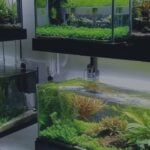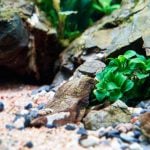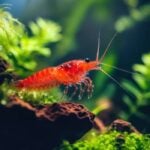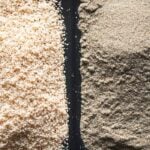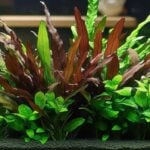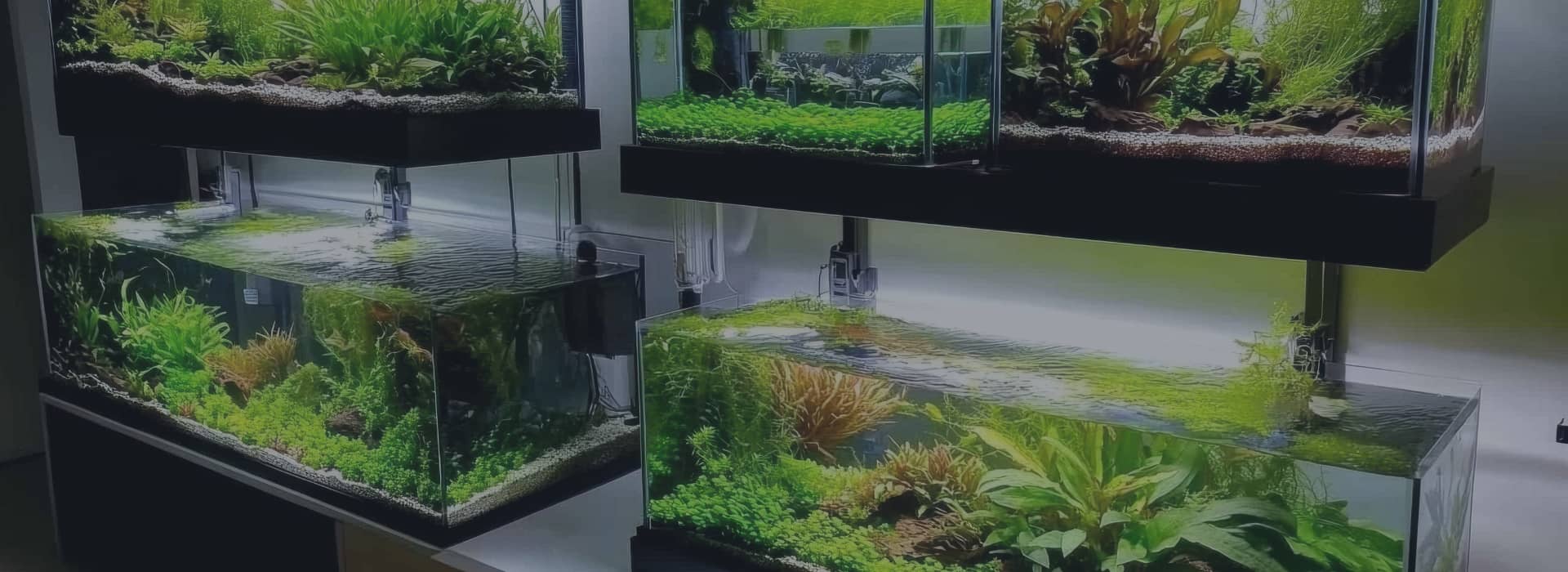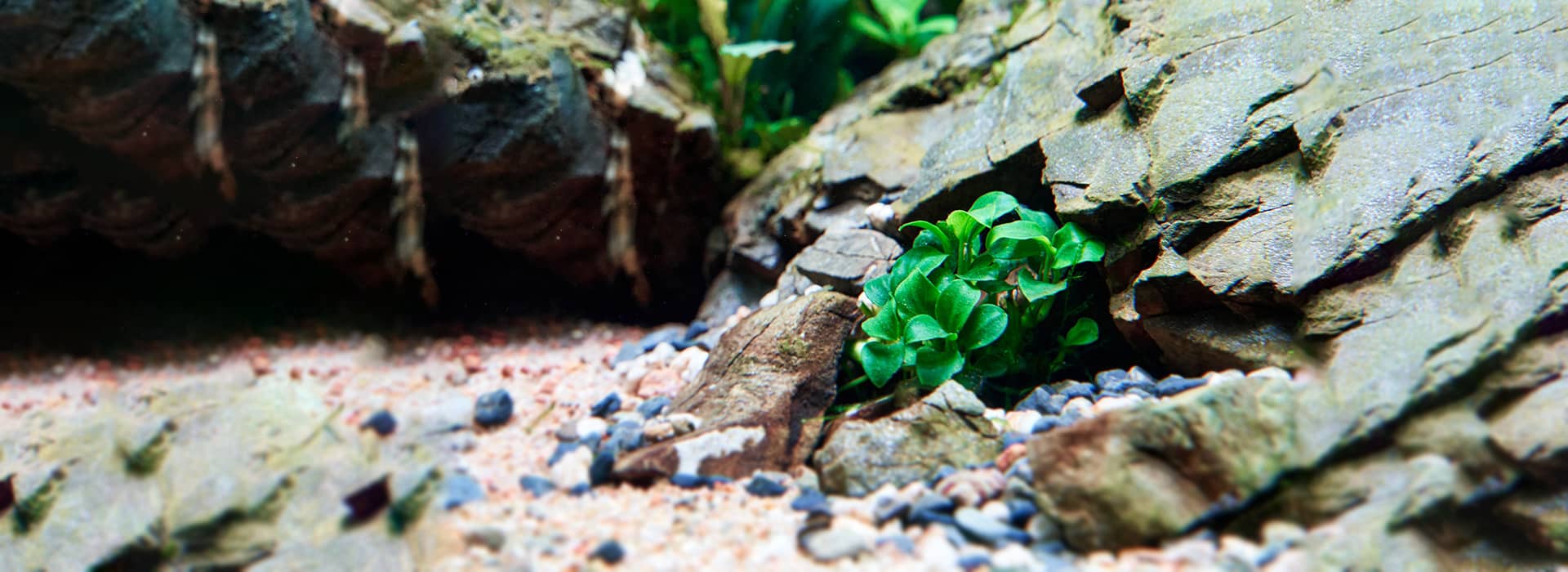The Substrate is the foundation for creating the perfect planted aquarium. In the art of aquascaping, the choice of substrate plays a crucial role in providing essential nutrients, supporting plant growth, and creating a stunning underwater landscape. A well-chosen substrate not only anchors aquatic plants but also contributes to the overall aesthetics of the aquarium, mimicking natural habitats and providing a nourishing environment for the thriving aquatic ecosystem.
Aquascaping Substrate come in a diverse range of options, from nutrient-rich soil to specialised gravel or sand, each tailored to specific needs and desired outcomes. The right substrate selection can help establish a balanced ecosystem, promote root development, and enhance the health and vibrancy of your aquatic plants. Here, I’ll explain the intricacies of aquascaping substrates, their benefits, considerations, and the techniques involved in using them to create a captivating and flourishing planted aquarium that will be the envy of every aquarist.
Importance of Substrate in Aquascaping
The substrate plays a vital role in aquascaping by providing a base on which the aquascape is built. Here are the key points highlighting the importance of substrate in aquascaping:
• Nutrient Supply: The substrate serves as a reservoir for essential nutrients needed for plant growth. It provides a source of nutrients, such as iron, potassium, and trace elements, which are absorbed by plant roots to support healthy development and vibrant foliage.
• Anchoring Plants: A suitable substrate allows aquatic plants to establish their root systems securely. It prevents plants from uprooting or floating away, ensuring stability and longevity within the aquarium.
• Root Development: The substrate’s composition and structure promote robust root development. It allows roots to penetrate easily, anchor firmly, and spread efficiently, providing plants with a strong foundation for optimal nutrient uptake.
• Biological Filtration: The substrate hosts beneficial bacteria that contribute to the nitrogen cycle in the aquarium. These bacteria break down harmful ammonia into less toxic compounds, helping to maintain water quality and creating a healthy environment for aquatic life.
• Aesthetics and Natural Environment: The substrate significantly contributes to the overall visual appeal of an aquascape. Different substrate types, colours, and textures can mimic natural habitats, from sandy riverbeds to lush forest floors, creating a more realistic and captivating look.
• Plant Growth and Health: A well-chosen substrate supports optimal plant growth, leading to healthier and more vibrant aquatic plants. Adequate root anchorage, nutrient availability, and proper water circulation within the substrate foster thriving plant life, contributing to the overall balance and beauty of the aquascape.
• Balance and Ecosystem Support: The substrate forms an integral part of the aquarium’s ecosystem. It provides a habitat for beneficial microorganisms, detritus-eating organisms, and other invertebrates that contribute to nutrient cycling, decomposition, and overall ecosystem balance.
In summary, selecting the right substrate is crucial in aquascaping as it provides essential nutrients, anchors plants, promotes root development, supports biological filtration, enhances aesthetics, and contributes to the overall health and balance of the aquarium. Choosing a suitable substrate is a fundamental step towards creating the perfect planted aquarium.
Types of Aquascaping Substrate
When it comes to aquascaping, various types of substrates are available to create the desired environment for your planted aquarium. Here are some common types of aquascaping substrates:
- Specialised Aquascape Soil: Soil-based substrates, such as specialised aquarium plant soils or nutrient-rich potting soils, provide a fertile base for plant growth. These substrates typically contain a blend of organic matter, clay, and minerals that release essential nutrients over time, promoting healthy plant development. This is the go-to choice for creating lush aquascapes with a lot of greenery.
- Gravel: Gravel is a popular choice for aquascaping substrate due to its versatility and availability in different grain sizes and colours. It provides stability for plant roots and allows for water circulation through the substrate. Gravel can be inert or come with a coating of nutrients, depending on the brand and type chosen.
- Sand: Sand substrates offer a smooth and appealing option for aquascaping. They come in various colours and grain sizes, providing a natural look to the aquarium. While sand may be less nutrient-rich than soil, it can be used in combination with root tabs or liquid fertilisers to support plant growth. It can also be layered on top of aquarium soil to create a unique look while keeping the nutrient level high.
- Mineralised Substrate: Mineralised substrates involve preparing a substrate mixture with a base material like topsoil or clay, which is then mineralised through a process of soaking, drying, and sieving. This method helps release essential nutrients and create a nutrient-rich substrate for plant growth.
- Aquatic Plant Mats: Aquatic plant mats consist of a thin layer of material embedded with plant roots and nutrients. These mats can be placed directly on the aquarium floor, providing instant green coverage and promoting rapid plant growth. However, they are not suitable for the long term.
- Substrate Additives: In addition to the base substrate, additives like root tabs, clay balls, or organic matter can be incorporated to supplement nutrient levels and support plant growth. Root tabs are small fertiliser capsules inserted into the substrate near plant roots to provide a localised nutrient supply.
Selecting the Right Substrate
Selecting the right substrate is crucial for creating a healthy and thriving planted aquarium. Here are some key factors to consider when choosing the ideal substrate for your aquascape:
- Plant Requirements: Different plant species have varying substrate preferences. Research the specific needs of the plants you plan to include in your aquarium. Some plants may require nutrient-rich substrates, while others can thrive in inert substrates. Account for the desired pH range, water hardness, and root structure of the plants to ensure compatibility with the chosen substrate.
- Nutrient Availability: Evaluate the nutrient requirements of your aquatic plants. Nutrient-rich substrates, such as soil-based substrates or specialised plant substrates, release essential nutrients gradually, providing a steady supply for plant uptake. Inert substrates like gravel or sand may require additional supplementation through root tabs or liquid fertilisers.
- Aquarium Setup: Larger tanks may require deeper substrate layers to provide ample space for plant roots. The substrate depth may also vary depending on the desired aquascape design, such as a carpeting effect or varying plant heights. Ensure that the chosen substrate can support the desired plant arrangement and aesthetic goals.
- Water Parameters: Take into account the current and target water parameters of your aquarium. Some substrates can influence water chemistry, affecting pH, water hardness, or nutrient levels. Choose a substrate that aligns with the desired water parameters for your aquatic plants and fish inhabitants. Use buffering agents or additives to maintain stable water conditions.
- Aesthetics: Choose a substrate colour, texture, and grain size that complements your desired aquascape design. Light-coloured substrates can enhance lighting, while darker substrates can provide a striking contrast with plants and fish.
- Maintenance: Fine substrates like sand may require more frequent cleaning to prevent debris buildup, while larger grain substrates like gravel may be easier to vacuum. Evaluate the substrate’s compatibility with cleaning equipment and the ability to prevent anaerobic pockets or excessive nutrient accumulation.
- Personal Preference: Finally, select a substrate that aligns with your personal preferences and the overall aesthetic you want to achieve in your aquascape. Balance the functional aspects, such as plant health and water parameters, with your desired visual outcome.
Nutrient-Rich Substrates
Nutrient-rich substrates are a popular choice for aquascaping due to their ability to provide essential nutrients to support healthy plant growth. Here are some key points about nutrient-rich substrates:
- Composition: Nutrient-rich substrates typically consist of a combination of organic matter, clay, and minerals. They are specifically formulated to release essential nutrients gradually over time, ensuring a steady supply for plant uptake.
- Nutrient Availability: These substrates are designed to provide a range of macro and micronutrients necessary for plant growth. Nutrients like nitrogen (N), phosphorus (P), potassium (K), iron (Fe), and trace elements are typically present in higher concentrations, promoting robust plant development and vibrant foliage.
- Root Development: Nutrient-rich substrates support healthy root development by providing a favourable environment for root penetration and expansion. The texture and composition of the substrate allow roots to spread easily, anchoring plants securely and facilitating efficient nutrient absorption.
- Long-Term Nutrient Release: Nutrient-rich substrates offer a long-lasting nutrient source, reducing the need for frequent fertiliser dosing or supplementation. They slowly release nutrients over an extended period, ensuring a sustained and balanced nutrient supply for aquatic plants.
- Plant Growth and Health: Nutrient-rich substrates contribute to lush and vibrant plant growth. They help to prevent nutrient deficiencies, promote strong root systems, and enhance overall plant health. With the proper balance of nutrients, plants can thrive and exhibit optimal colouration, leaf development, and growth rates.
- Nutrient Cycling: Nutrient-rich substrates support the biological processes within the aquarium ecosystem. Beneficial bacteria and microorganisms present in the substrate help break down organic matter and convert nutrients, aiding in the natural nutrient cycling process and maintaining water quality.
- Considerations: Nutrient-rich substrates can influence water parameters, such as pH and water hardness, due to the release of organic compounds and mineral content. It’s essential to monitor these parameters and make necessary adjustments to ensure compatibility with the needs of the plants and other aquatic inhabitants in your aquarium.
I would recommend nutrient-rich substrates for anyone wishing to create lush aquascapes. They are also the best option for demanding plants. Rich in macronutrients like nitrogen, phosphorus, and potassium, as well as micronutrients such as iron, manganese, and zinc, these substrates feed the plant’s root system, promoting healthy, vigorous growth. Nutrient-rich substrates also help maintain the necessary pH balance, support a thriving biofilter, and assist in water clarity by binding excessive nutrients, all of which are indispensable for the lush, balanced growth of both demanding and more tolerant species of plants.
They do need a bit more work though. Maintaining nutrient-rich aquarium substrates requires careful attention to ensure that they continue to provide the nourishment your aquatic plants need while preserving water quality. Over time, nutrient-rich substrates may deplete and will require replenishment. This can be achieved through root tabs or substrate additives, which replenish essential nutrients without disturbing the established biological balance. Monitoring the health of your plants can give indications of nutrient deficiencies – yellowing leaves or slow growth, for example, may signal a need for more nutrients. This breakdown does take a few years though and by then, you will have the necessary expertise to replenish the substrate.
Inert Substrates
Inert substrates are a popular choice for aquascaping due to their stability, versatility, and ease of maintenance. Here are some key points about inert substrates:
- Composition: Inert substrates are typically made from materials like gravel, sand, or crushed rock that do not actively provide nutrients to plants. They do not undergo significant breakdown or decomposition processes like nutrient-rich substrates.
- Stability: Inert substrates offer stability within the aquarium, as they do not break down over time. They provide a reliable foundation for plant roots and prevent plants from uprooting or shifting in the substrate.
- Water Parameters: Inert substrates have minimal impact on water parameters, such as pH and water hardness. They do not release or alter the mineral content of the water, allowing for greater control over the aquarium’s specific water chemistry requirements.
- Supplementing Nutrients: Since inert substrates do not provide significant nutrients on their own, they require additional supplementation to support plant growth. This can be achieved through the use of root tabs or liquid fertilisers placed near the plant roots. Regular dosing ensures that plants receive the necessary macro and micronutrients.
- Versatility: Inert substrates come in various grain sizes and colours, allowing aquarists to create different aesthetic effects. Fine sands create a sleek and clean appearance, while larger gravel sizes offer a more textured and natural look. The choice of inert substrate can be tailored to the specific aquascape design and desired visual impact.
- Ease of Maintenance: Inert substrates are relatively easy to maintain. They do not decompose or release organic matter, reducing the risk of nutrient imbalances or the formation of anaerobic pockets. Cleaning and vacuuming the substrate during regular maintenance routines help prevent debris buildup and maintain overall water quality.
- Compatibility: Inert substrates are compatible with plant species that aren’t too demanding. They can support various root structures and allow for adequate water circulation and oxygenation around the plant roots.
Monitor plant nutrient requirements, observe plant growth, and provide regular nutrient supplementation to ensure healthy and vibrant plant development. Combining inert substrates with appropriate lighting, CO2 supplementation (if needed), and regular water care practices can result in a successful planted aquarium.
Choosing Substrate for Specific Aquascaping Styles
When it comes to specific aquascaping styles, choosing the right substrate will go a long way in achieving the desired look and creating the perfect environment that complements the overall design. Here are some considerations for selecting substrates for popular aquascaping styles:
- Dutch-Style Aquascapes: Dutch-style aquascapes are known for their lush and densely planted arrangements with a focus on colourful and contrasting plant species. For this style, nutrient-rich substrates are commonly used to provide a fertile base for the plants. Soil-based substrates or specialised plant substrates can help promote vibrant plant growth and provide a rich nutrient supply for the demanding plant selection.
- Nature-Style Aquascapes: Nature-style aquascapes aim to recreate the natural look of a specific landscape, such as a forest or meadow. Inert substrates like fine gravel or sand are commonly used to mimic the natural appearance of riverbeds or sandy soil. Choosing substrates with earthy tones can enhance the natural feel of the aquascape. For those nature-style aquascapes with demanding plants, nutrient-rich soil can be used underneath the inert substrate to meet the nutritional needs of these plants.
- Iwagumi-Style Aquascapes: Iwagumi-style aquascapes focus on simplicity and minimalism, typically featuring a single, prominent rock as the centrepiece. Inert substrates like fine sand or small-sized gravel are often used to create a clean and uncluttered appearance, ensuring that the attention is primarily on the rocks and carefully arranged plants.
- Biotope-Style Aquascapes: Biotope-style aquascapes aim to replicate specific natural habitats, such as Amazonian rivers or Asian rice fields. Research the natural substrate types found in the targeted habitat and try to mimic them as closely as possible. This may involve using specific sands, gravels, or soils that match the characteristics of the chosen biotope.
- Wabi-Kusa Aquascapes: Wabi-Kusa is a style that involves using plants grown in emersed form on a substrate medium that retains moisture. Specialised substrates designed for Wabi-Kusa, such as clay or planting soil mixes, can provide the necessary moisture and nutrient supply for these unique aquascapes.
- Paludariums and Ripariums: These styles incorporate both aquatic and terrestrial plants. The substrate choices will depend on the specific plant requirements for the aquatic and terrestrial sections. For the aquatic part, nutrient-rich substrates or specific aquatic plant soils can be used, while for the terrestrial section, suitable soils or substrates for land-based plants should be considered.
Best Brands Of Aquascaping Substrate In Australia
There are several reputable brands of aquascaping substrates available in Australia that are well-regarded by aquarists. Here are some popular and trusted brands known for their quality aquascaping substrates:
- ADA (Aqua Design Amano): ADA is a renowned brand in the aquascaping world, offering a range of high-quality substrates designed specifically for planted aquariums. Their ADA Aquasoil and ADA Power Sand are popular choices among aquascapers, known for their nutrient-rich composition and ability to promote healthy plant growth.
- Tropica: Tropica is another well-known brand that offers a variety of substrates suitable for aquascaping. Their Tropica Aquarium Soil is a nutrient-rich substrate that supports optimal plant growth and provides a fertile base for aquatic plants. Tropica also offers specialised substrates like Tropica Plant Growth Substrate and Tropica Aquarium Sand.
- Fluval: Fluval is another trusted brand that provides a range of substrates suitable for aquascaping. Their Plant and Shrimp Stratum substrate is popular among aquascapers for its nutrient-rich composition, which promotes plant growth and provides a favourable environment for shrimp and other invertebrates.
- Oliver Knott Aqua Design: Oliver Knott Aqua Design offers a range of aquascaping substrates designed to enhance plant growth and aesthetics. Their NatureSoil and AquaIron substrates are well-regarded by aquarists for their nutrient content, ability to maintain stable water parameters and support healthy plant growth.
- Brightwell Aquatics: Brightwell Aquatics offers substrates specifically designed for planted aquariums. Their FlorinBase series provides a comprehensive range of substrates with different nutrient profiles to cater to various aquascaping needs. They are known for their balanced nutrient release and ability to create a suitable environment for aquatic plants.
These are just a few of the notable brands available in Australia, and each brand may offer multiple substrate options. It’s recommended to research further, read product reviews, and consider the specific requirements of your aquarium and plants before making a final decision.
Why Using Garden Soil As Aquascape Substrate Isn’t A Good Idea
Using garden soil as an aquascape substrate can be quite tempting but it is a risky choice and is generally not recommended. Here’s why:
- Nutrient Imbalance: Garden soil is designed for outdoor use and may contain an excessive amount of nutrients or elements that are unsuitable for aquarium plants. The nutrient content of garden soil can vary widely, leading to imbalances that can harm or even kill your aquatic plants.
- Organic Matter and Decomposition: Garden soil often contains organic matter, such as decomposing leaves or twigs, which can release excess nutrients, cause water cloudiness, and lead to poor water quality. It can also create anaerobic conditions in the substrate, potentially producing toxic gases harmful to aquatic life.
- pH and Water Chemistry: Garden soil may have an unpredictable effect on water pH and hardness due to its composition. These fluctuations can stress or harm sensitive aquatic organisms. Maintaining stable water parameters is crucial for the health of the aquarium ecosystem.
- Potential Contaminants: Garden soil can contain various contaminants, such as pesticides, fertilisers, and pollutants, which can leach into the aquarium water and harm aquatic life. These contaminants can have detrimental effects on fish, invertebrates, and even the plants themselves.
- Lack of Control: Unlike specialised aquascaping substrates, garden soil does not offer precise control over nutrient content, pH, or water chemistry. It can be challenging to maintain a stable and balanced environment for your plants and aquatic life.
Instead of using garden soil, it is recommended to opt for substrates specifically formulated for aquatic plant growth. Nutrient-rich substrates designed for planted aquariums, such as specialised aquasoils or plant-specific substrates, offer controlled nutrient release, stability, and compatibility with aquatic ecosystems. They may increase your expenditure but the extra cost is well worth the peace of mind and stability they offer.
FAQ
What is aquascaping substrate?
Aquascaping substrate refers to the material or mixture used as the foundation in a planted aquarium. It provides a medium for plant roots, nutrient availability, and contributes to the overall aesthetics of the aquascape.
What are the different types of aquascaping substrates available?
Common types of aquascaping substrates include nutrient-rich soil, gravel, sand, specialised planted tank substrates, and mineralised substrates. Each type has its benefits and considerations.
How do I choose the right substrate for my aquarium?
Factors such as plant requirements, nutrient availability, aquarium setup, water parameters, aesthetics, and ease of maintenance will help you when selecting the substrate. Researching specific plant needs and understanding your aquascape goals will help guide your decision.
Do I need a nutrient-rich substrate for a planted aquarium?
It depends on the plant species and your desired level of plant growth. Nutrient-rich substrates can provide a steady nutrient supply, but inert substrates can be supplemented with root tabs or liquid fertilisers for adequate plant nutrition.
How deep should the substrate be in a planted aquarium?
The recommended substrate depth is typically 5-8 cm or (2-3 inches) to accommodate plant roots and ensure stability. However, the depth can vary depending on the plants being used and the desired aquascape design.
Can I mix different types of substrates?
Yes, you can mix substrates to achieve desired characteristics or create visual effects. For example, layering nutrient-rich soil under a layer of gravel or sand can provide both nutrient availability and visual appeal.
How often should I clean the substrate?
Regular substrate maintenance involves removing debris and vacuuming to prevent the buildup of organic matter. The frequency of cleaning depends on the aquarium’s condition and the presence of excess debris.
Can I reuse substrate from an existing aquarium?
It is possible to reuse substrate, but it’s essential to clean and sterilise it properly before reuse to avoid introducing harmful substances or pests into the new aquarium.
Can I change the substrate in an established aquarium?
Changing the substrate in an established aquarium can be challenging and may disturb the aquarium’s balance. It’s generally recommended to do so during a tank reset or when planning a significant aquascape overhaul.
Conclusion
The substrate serves as the foundation for plant growth, provides essential nutrients, and contributes to the overall aesthetics of the aquascape. By understanding the different types of substrates available and factoring in plant requirements, water parameters, and maintenance needs, aquarists can make informed decisions to create a thriving and stunning underwater landscape.
The right substrate choice sets the stage for healthy plant growth, robust root development, and a balanced aquarium ecosystem. Nutrient-rich substrates offer a steady supply of essential nutrients, while inert substrates provide stability and versatility. Additionally, specialised substrates and additives cater to particular needs and aquascaping styles.
Remember that each aquarium is unique, and the needs of your plants, water parameters, and personal preferences can vary. By combining the right substrate with appropriate lighting, CO2 supplementation (if needed), and regular care, you can create a flourishing planted aquarium that brings joy and beauty to your aquatic world.
